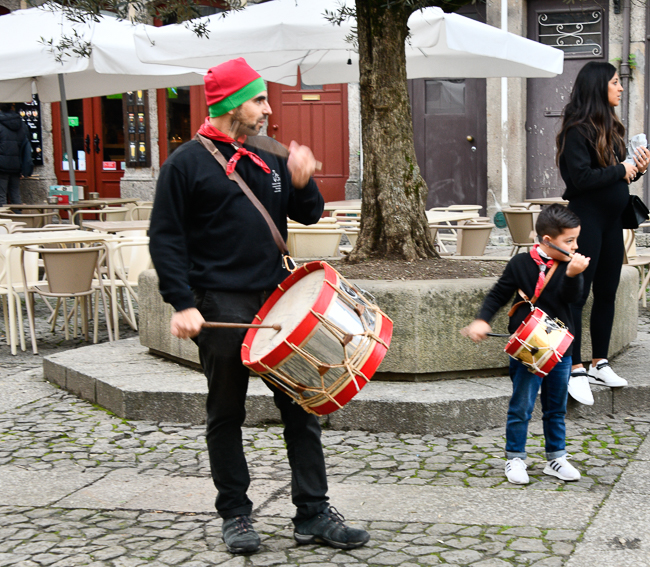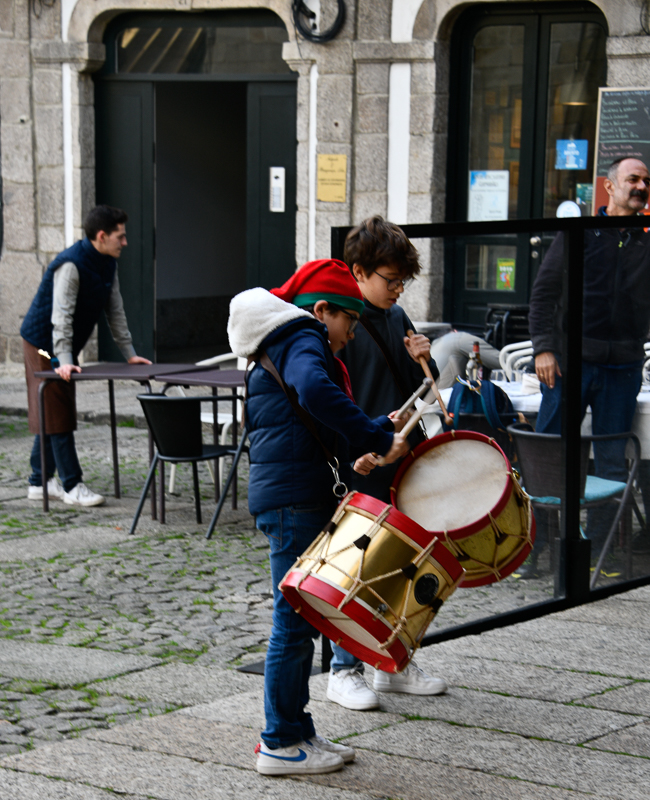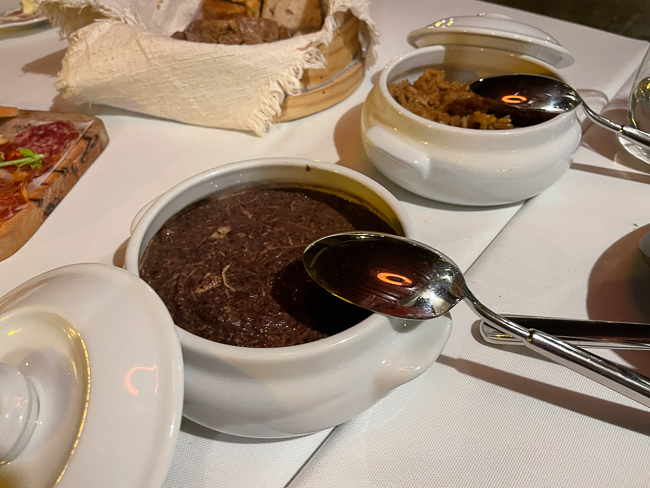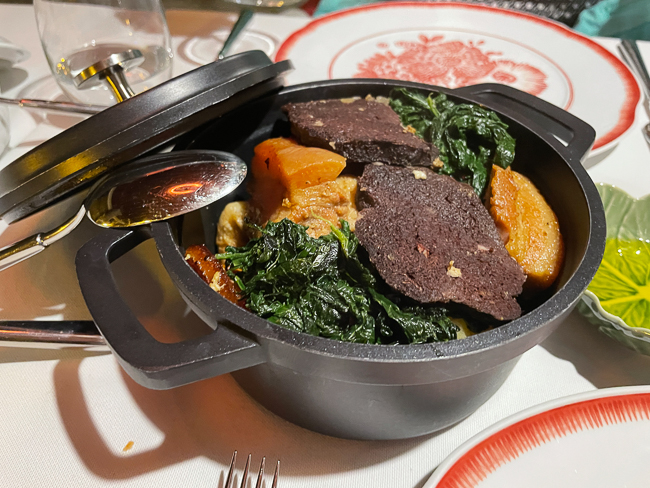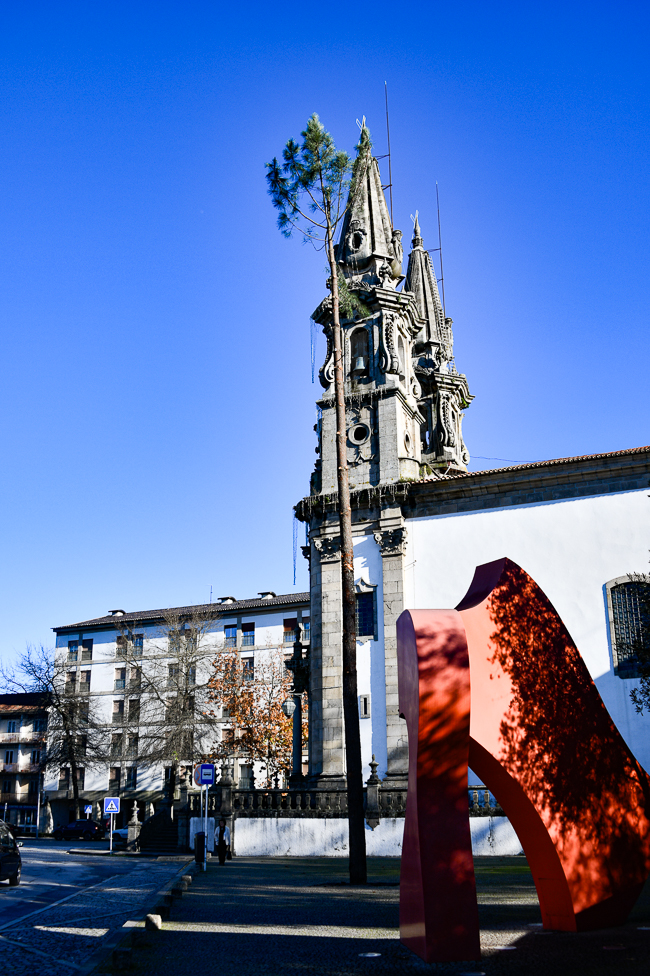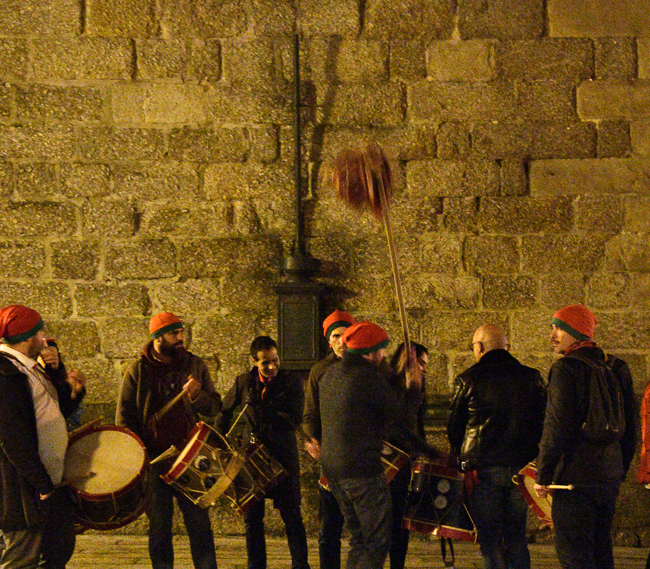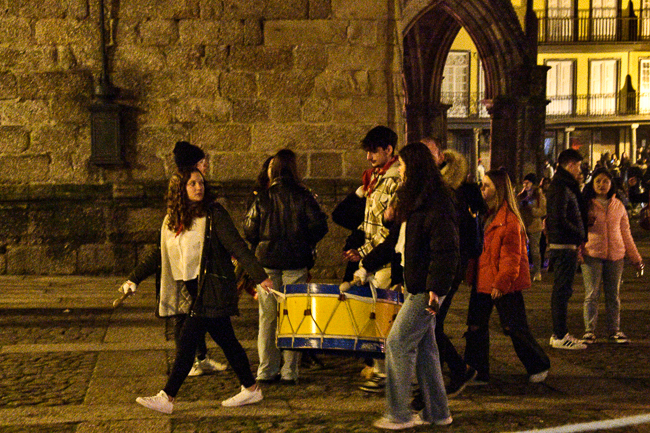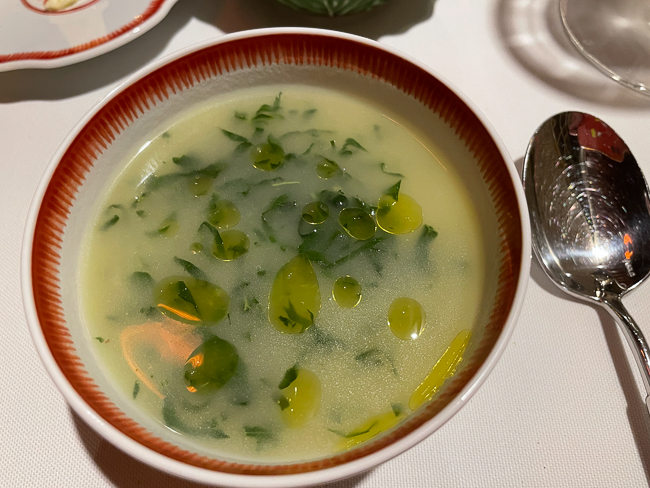November 29th 2022
Saint Nicolinas
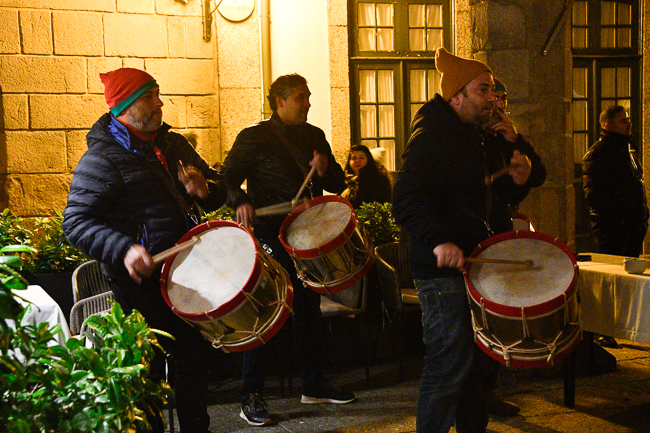 We are here for the beginning of the festivities of Saint Nicolinas.
We are here for the beginning of the festivities of Saint Nicolinas.
St. Nicholas is also the patron of students. Legend has it that three school-age children were cut in pieces by an innkeeper, and when St. Nicholas approached them, he brought them back to life.
Originally the celebrations in honor of St. Nicholas in Guimarães were exclusively religious by nature but were later appropriated by students.
Today, festivities take place between November 29th and December 7th and comprise several Nicolino Traditions.
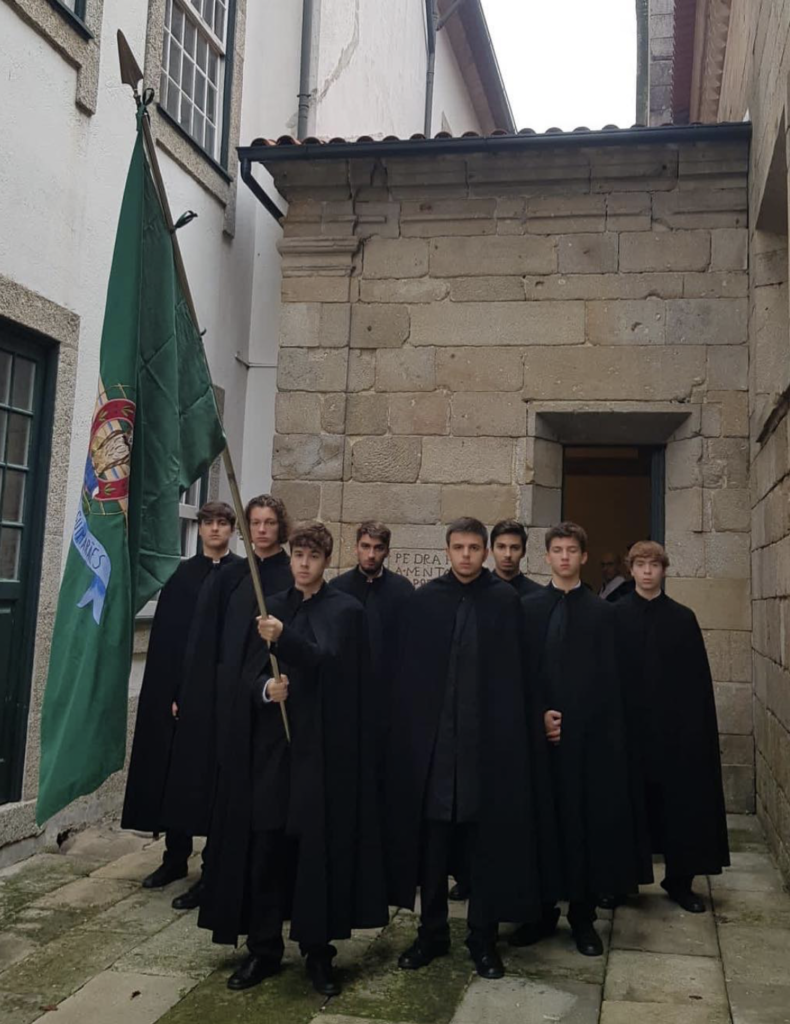
Photo from the Nicolinos Facebook Page -Pilgrimage of Longing. Today, November 1st, the Nicolinas Festival Committee headed to the Atouguia Cemetery to pay homage to the deceased Old Nicolinos, thus performing their first official act.
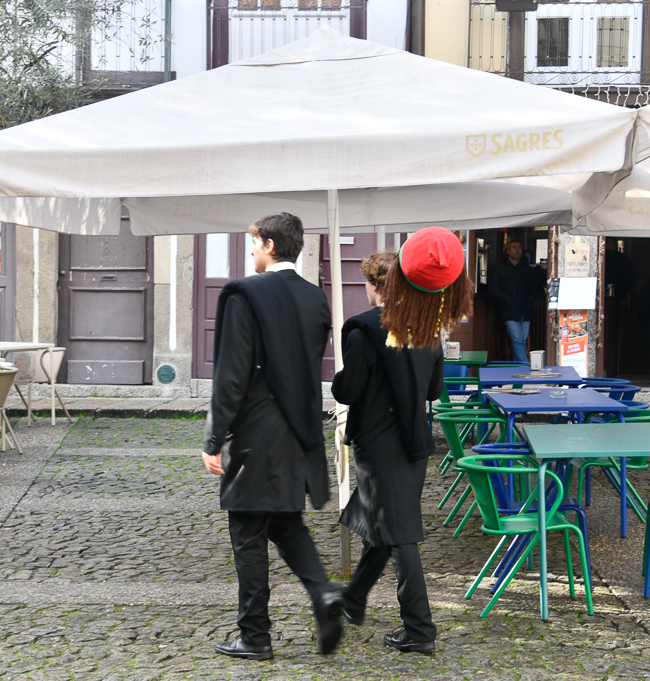
There was a parade on the morning of the 28th. Afterward, I spotted these gentlemen carrying a red-capped long haired head on a pole.
The only celebrations occurring while we are here are the Burial of the Pine and the Nicoline Suppers.
Long before the official ceremony begins the children fill the streets and drum. This began around 2:00 in the afternoon. While my room is on a side street off of the main square the continual drumming is much louder than one would think. The buildings in the area are hundreds of years old and made of stone, the perfect amplifier. I had earplugs in by 3:00.
It is important to know that the drumming is intentional. There is a rhythm and a cadence that is practiced, and watching the drummers you realize they take their drumming very seriously, this is not drumming for the sake of noise.
The Nicoline suppers are when students and former students of Guimarães gather in restaurants to have a traditional dinner consisting of rojões and sarrabulho porridge, accompanied by lots and lots of vinho verde.
When the dinner is over the Pine Parade (Pinheiro Procession) begins, around midnight.
A mast made from a pine tree is decorated with balloons and red and white banners. It is hauled through town by an ox and eventually ends in the square next to the Church of Santos Passos where it is hoisted upwards and where it remains until the end of the Nicolinas celebrations.
The students fill the streets, banging drums, this goes on until the sun comes up. (Yes, we did receive a nice email from our hotel warning us of the celebration ahead of time).
There are many people that carry a big head on a stick and I have heard that some even beat time with a large head of Portuguese cabbage. However, the majority simply use a long stick with lots of ribbons tied to the end. These people are responsible for setting the beat of the drummers.
The truth is, I don’t even know if these beat keepers are necessary. The rhythm is so traditional and repetitive that everyone knows it enough to repeat it in their sleep. Most simply pump their arms to the rhythm it is so catchy.
Traditionally girls were not allowed to participate in the Pinheiro Procession. However, that has really changed, I saw as many female drummers as male drummers.
Since girls were not traditionally allowed to participate “Little Apples” held on December 6th was lady’s night. Here the girls stand on the balconies and in the windows of Saint Tiago Square, watching the boys’ allegorical procession. Each boy has a spear decorated with ribbons, that he lifts up to declare his love, with hopes that the girl does the same in return by placing an apple on the spear.
*
Portuguese cabbage
The people that used cabbage for setting the time of the drummers in the Pine Parade would have no problem finding a baton. These cabbages grow in almost every garden in the region.
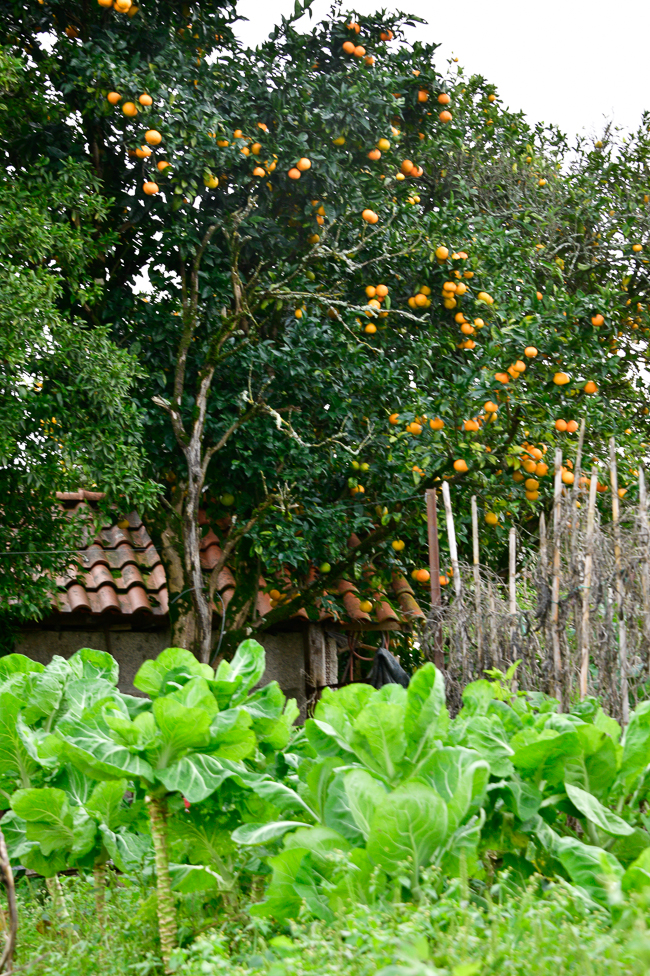 Portuguese cabbage is a leafy green vegetable in the brassica family. However, it isn’t like the cabbage that most think of. This vegetable doesn’t form heads and grows in leaves like kale. The Portuguese let the stalks get very very tall, thus the perfect use as a baton.
Portuguese cabbage is a leafy green vegetable in the brassica family. However, it isn’t like the cabbage that most think of. This vegetable doesn’t form heads and grows in leaves like kale. The Portuguese let the stalks get very very tall, thus the perfect use as a baton.
The cabbage is most famous for making Portuguese Green Cabbage Soup, or Caldo Verde which has been eaten for centuries in the Minho Region. If done correctly is absolutely delicious.
In 2011, Portugal held a nationwide contest to determine which local delicacies would be deemed “the 7 Wonders of Portuguese Cuisine.” Although the final list was disputed the one dish everyone agreed on was Caldo Verde, which literally means “green broth.”
I say if done properly because today, as the soup has spread across Portugal, there are just about as many variations of this recipe as there are Portuguese kitchens.
Here is a recipe that sounded most like the one I found to be the best I ate while here.
Ingredients
1 large onion
2 cloves of garlic
700 g potatoes
300 g kale or cavolo nero
extra virgin olive oil
150 g higher-welfare chorizo
paprika
Method
Peel and finely chop the onion and garlic, dice the potatoes, finely shred the kale or cavolo nero, and slice the chorizo.
Heat 4 tablespoons of oil in a saucepan over medium heat and fry the onion and garlic for 5 minutes, or till they begin to soften.
Stir in the potatoes, season with sea salt, and cook for a further 5 minutes. Add 1.25 liters of water and simmer for 20 minutes, or until the potatoes are soft.
Mash the potatoes into the liquid to produce a smooth purée. Add the kale and simmer for 5 minutes.
Heat 1 tablespoon of oil in a frying pan over medium heat and fry the chorizo slices, sprinkling paprika over them in the pan, for 3 to 4 minutes.
Add the chorizo to the soup, then ladle the soup into bowls and season with freshly ground black pepper.
